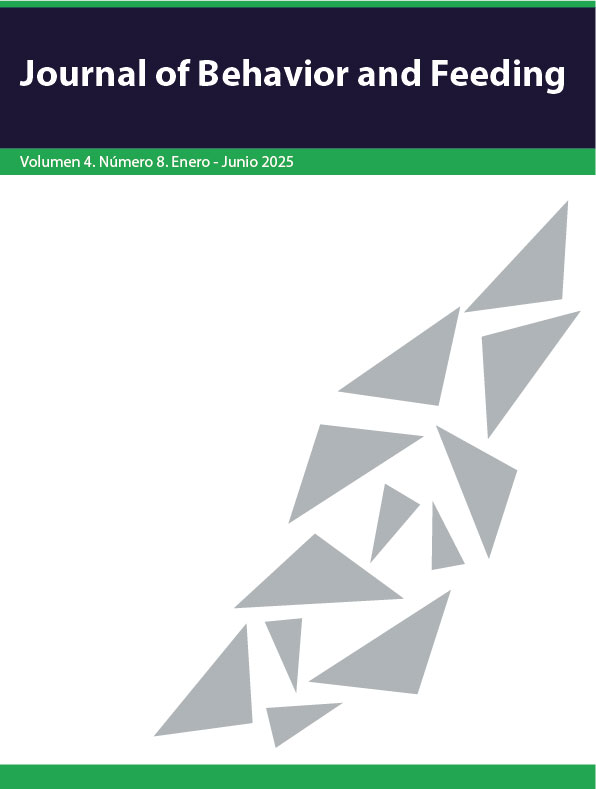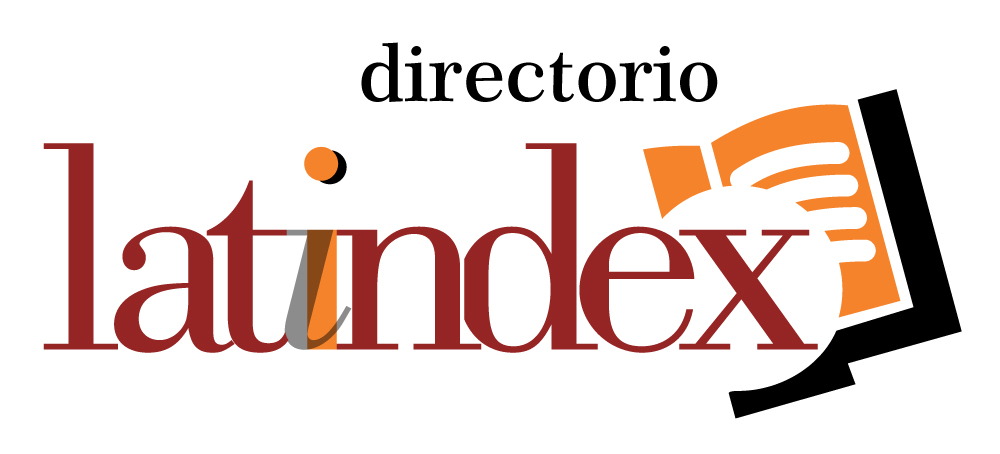Perinatal programming effects on feeding behavior
DOI:
https://doi.org/10.32870/jbf.v4i8.67Keywords:
feeding behavior, hyperphagia, diet, obesity, perinatal programmingAbstract
To address the growing prevalence of obesity and its associated metabolic consequences, it is essential to understand the evolutionary origins of health and disease. Current evidence attributes the rise in obesity to environmental factors, such as the Western diet and unhealthy lifestyles. However, this review argues that adverse conditions during early developmental stages significantly influence adult health outcomes. It has been proposed that an adverse perinatal environment triggers adaptive physiological changes that ensure fetal survival but simultaneously increase the long-term risk of chronic diseases. In addition to structural and functional alterations in the organism, changes in feeding behavior have been identified and linked to the presence of chronic non-communicable diseases. This narrative review aims to present the last half century’s worth of evidence regarding the impact of in-utero environmental changes on eating behavior within the framework of perinatal programming theory.
Downloads
References
Aguayo-Guerrero, J. A., León-Cabrera, S., & Escobedo, G. (2023). Molecular mechanisms involved in fetal programming and disease origin in adulthood. Journal of Pediatric Endocrinology and Metabolism, 36(7), 615-627. http://doi.org/10.1515/jpem-2022-0491
Barbero, A., Astiz, S., Ovilo, C., Lopez-Bote, C. J., Perez-Solana, M. L., Ayuso, M., Garcia-Real, I., & Gonzalez-Bulnes, A. (2014). Prenatal programming of obesity in a swine model of leptin resistance: Modulatory effects of controlled postnatal nutrition and exercise. Journal of Developmental Origins of Health and Disease, 5, 248-258. http://doi.org/10.1017/S2040174414000208
Barker, D. J. P. (1990). The fetal and infant origins of adult disease. BMJ, 301, 1111. http://doi.org/10.1136/bmj.301.6761.1111
Barker, D. J. P. (2004). The developmental origins of chronic adult disease. Acta Paediatrica, 93, 26-33. http://doi.org/10.1080/08035320410022730
Bayol, S. A., Farrington, S. J., & Stickland, N. C. (2007). A maternal “junk food” diet in pregnancy and lactation promotes an exacerbated taste for “junk food” and a greater propensity for obesity in rat offspring. British Journal of Nutrition, 98, 843-851. http://doi.org/10.1017/S0007114507812037
Bellinger, L, Sculley, D. V, & Langley-Evans, S. C. (2006). Exposure to undernutrition in fetal life determines fat distribution, locomotor activity and food intake in ageing rats. International Journal of Obesity, 30, 729-738. http://doi.org/10.1038/sj.ijo.0803205
Bellinger, L., & Langley-Evans, S. C. (2005). Fetal programming of appetite by exposure to a maternal low-protein diet in the rat. Clinical Science, 109, 413-420. http://doi.org/10.1042/CS20050127
Bellinger, L., Lilley, C., & Langley-Evans, S. C. (2004). Prenatal exposure to a maternal low-protein diet programmes a preference for high-fat foods in the young adult rat. British Journal of Nutrition, 92, 513. http://doi.org/10.1079/BJN20041224
Breier, B. H., Vickers, M. H., Ikenasio, B. A., Chan, K. Y., & Wong, W. P. S. (2001). Fetal programming of appetite and obesity. Molecular and Cellular Endocrinology, 185, 73–79. http://doi.org/10.1016/S0303-7207(01)00634-7
Camacho-Morales, A., Caballero-Benitez, A., Vázquez-Cruz, E., Maldonado-Ruíz, R., Cardenas-Tueme, M., Rojas-Martínez, A., & Caballero-Hernández, D. (2022). Maternal programming by high-energy diets primes ghrelin sensitivity in the offspring of ras exposed to chronic immobilization stress. Nutrition Research, 107, 37-47. https://doi.org/10.1016/j.nutres.2022.08.007
Colombo, J., Gustafson, K. M., & Carlson, S. E. (2019). Critical and sensitive periods in development and nutrition. Annals of Nutrition and Metabolism, 75, 34-42. https://doi.org/10.1159/000508053.
Cripps, R. L., Martin-Gronert, M. S., & Ozanne, S. E. (2005). Fetal and perinatal programming of appetite. Clinical Science, 109, 1-11. http://doi.org/10.1042/CS20040367
Da Silva Cunha, F., Dalle Molle, R., Portella, A. K., Da Silva Benetti, C., Noschang, C., Goldani, M. Z., & Silveira, P. P. (2015). Both food restriction and high-fat diet during gestation induce low birth weight and altered physical activity in adult rat offspring: The “similarities in the inequalities” model. PLOS ONE, 10, 1-18. http://doi.org/10.1371/journal.pone.0118586
Dalle Molle, R., Laureano, D. P., Alves, M. B., Reis, T. M., Desai, M., Ross, M. G., & Silveira, P. P. (2015). Intrauterine growth restriction increases the preference for palatable foods and affects sensitivity to food rewards in male and female adult rats. Brain Research, 1618, 41-49. http://doi.org/10.1016/j.brainres.2015.05.019
de Boo, H. A., & Harding, J. E. (2006). The developmental origins of adult disease (Barker) hypothesis. Australian and New Zealand Journal of Obstetrics Gynaecology, 46(1), 4-14. http://doi.org/10.1111/j.1479-828X.2006.00506.x
De Moura, E. G., & Passos, M. C. F. (2005). Neonatal programming of body weight regulation and energetic metabolism. Bioscience Reports, 25, 251-269. http://doi.org/10.1007/s10540-005-2888-3
De Oliveira, J. C., Grassiolli, S., Gravena, C., & De Mathias, P. C. F. (2012). Early postnatal low-protein nutrition, metabolic programming and the autonomic nervous system in adult life. Nutrition and Metabolism, 9, 1-8. http://doi.org/10.1186/1743-7075-9-80
Desai, M., Gayle, D., Han, G., & Ross, M. G. (2007). Programmed hyperphagia due to reduced anorexigenic mechanisms in intrauterine growth-restricted offspring. Reproductive Sciences, 14, 329-337. http://doi.org/10.1177/1933719107303983
Desai, M., & Hales, C. N. (1997). Role of fetal and infant growth in programming metabolism in later life. Biological Reviews of the Cambridge Philosophical Society, 72, 329-348. http://doi.org/10.1017/S0006323196005026
Dötsch, J., Alejandre-Alcazar, M., Janoschek, R., Nüsken, E., Weber, L. T., & Nüsken, K. D. (2016). Perinatal programming of renal function. Current Opinion in Pediatrics, 28(2), 188-94. http://doi.org/10.1097/MOP.0000000000000312
Drake, A. J., Walker, B. R., & Seckl, J. R. (2005). Intergeneracional consequences of fetal programming by in utero exposure to glucocorticoids in rats. American Journal of Physiology. Regulatory, Integrative and Comparative Physiology, 288, 34-38. http://doi.org/10.1152/ajpregu.00106.2004
Erhuma, A., Bellinger, L., Langley-Evans, S. C., & Bennett, A. J. (2007). Prenatal exposure to undernutrition and programming of responses to high-fat feeding in the rat. British Journal of Nutrition, 98, 517. http://doi.org/10.1017/S0007114507721505
Fowden, A. L. (2006). Intrauterine programming of physiological systems: Causes and consequences. Physiology, 21, 29-37. https://org/10.1152/physiol.00050.2005
Fowden, A. L., Forhead, A. J., Coan, P. M., & Burton, G. J. (2008). The placenta and intrauterine programming. Journal of Neuroendocrinology, 20, 439-450. http://doi.org/10.1111/j.1365-2826.2008.01663.x
Galjaard, S., Devlieger, R., & Van Assche, F. A. (2013) Fetal growth and developmental programming. Journal of Perinatal Medicine, 41(1), 101-105. http://doi.org/10.1515/jpm-2012-0020
Godfrey, K. M., & Barker, D. J. (2001). Fetal programming and adult health. Public Health Nutrition, 4. http://doi.org/10.1079/PHN2001145
Grigore, D., Ojeda, N. B., & Alexander, B. T. (2008). Sex differences in the fetal programming of cardiovascular disease. Gender Medicine, 5, 121-132. http://doi.org/10.1016/j.genm.2008.03.012
Hales, C. N., & Barker, D. J. P. (2001). The thrifty phenotype hypothesis: Type 2 diabetes. British Medical Bulletin, 60, 5-20. http://doi.org/10.1093/bmb/60.1.5
Han, W., Song, Z., Shan, D., & Shi, Q. (2023). Fetal origins of obesity: a novel pathway of regulating appetite neurons in the hypothalamus of growth-restricted rat offspring. Archives of Gynecology and Obstetrics, 309(6), 2411-2419. http://doi.org/10.1007/s00404-023-07108-3.
Hong, J. Y. (2022). Developmental programming by perinatal glucocorticoids. Molecules and Cells, 45(10), 685-691. http://doi.org/10.14348/molcells.2022.0042
Jones, J. E., Jurgens, J. A., Evans, S. A., Ennis, R. C., Villar, V. A. M., & Jose, P. A. (2012). Mechanisms of fetal programming in hypertension. International Journal of Pediatrics, 2012(1), 584831. http://doi.org/10.1155/2012/584831
Kulhanek, D., Abrahante Llorens, J. E., Buckley, L., Tkac, I., Rao, R., & Paulsen, M. E. (2022). Female and male C57BL/6J offspring exposed to maternal obesogenic diet develop altered hypothalamic energy metabolism in adulthood. American Journal of Physiology-Endocrinology and Metabolism, 323(5), E448-E466. http://doi.org/10.1152/ajpendo.00100.2022
Langley-Evans, S. C. (2009). Nutritional programming of disease: Unravelling the mechanism. Journal of Anatomy, 215, 36-51. http://doi.org/10.1111/j.1469-7580.2008.00977.x
Langley-Evans, S. C., Bellinger, L., & McMullen, S. (2005). Animal models of programming: Early life influences on appetite and feeding behaviour. Maternal and Child Nutrition, 1, 142-148. http://doi.org/10.1111/j.1740-8709.2005.00015.x
Lesage, J., Del-Favero, F., Leonhardt, M., Louvart, H., Maccari, S., Vieau, D., & Darnaudery, M. (2004). Prenatal stress induces intrauterine growth restriction and programmes glucose intolerance and feeding behaviour disturbances in the aged rat. Journal of Endocrinology, 181, 291-296. http://doi.org/10.1677/joe.0.1810291
López, M., Seoane, L. M., Tovar, S., García, M. C., Nogueiras, R., Diéguez, C., & Señarís, R. M. (2005). A posible role of neuropeptide Y, agouti-related protein and leptin receptor isoforms in hypothalamic programming. Diabetologia, 48, 140-148. http://doi.org/10.1007/s00125-004-1596-z
Micho?ska, I., ?uszczki, E., Zieli?ska, M., Oleksy, ?., Stolarczyk, A., & Dere?, K. (2022). Nutritional programming: History, hypotheses, and the role of prenatal factors in the prevention of metabolic diseases - a narrative review. Nutrients, 14(20), 4422. http://doi.org/ 10.3390/nu14204422.
Miles, J. L., Landon, J., Davison, M., Krägeloh, C. U., Thompson, N. M., Triggs, C. M., & Breier, B. H. (2009). Prenatally undernourished rats show increased preference for wheel running v. lever pressing for food in a choice task. British Journal of Nutrition, 101, 902-908. http://doi.org/10.1017/S0007114508043353
Nathanielsz, P. W. (2006). Animal models that elucidate basic principles of the developmental origins of adult diseases. ILAR Journal, 47, 73–82. http://doi.org/10.1093/ILAR.47.1.73
Ong, Z. Y., & Muhlhausler, B. S. (2014). Consuming a low-fat diet from weaning to adulthood reverses the programming of food preferences in male, but not in female, offspring of ’junk food’-fed rat dams. Acta Physiologica, 210, 127-141. http://doi.org/10.1111/apha.12132
Orozco-Sólis, R., Lopes de Souza, S., Barbosa Matos, R. J., Grit, I., Le Bloch, J., Nguyen, P., Manhães de Castro, R., & Bolaños-Jiménez, F. (2009). Perinatal undernutrition-induced obesity is independent of the developmental programming of feeding. Physiology and Behavior, 96, 481-492. http://doi.org/10.1016/j.physbeh.2008.11.016
Oscai, L. B., & McGarr, J. A. (1978). Evidence that the amount of food consumed in early life fixes appetite in the rat. The American Journal of Physiology, 235, 141-144. http://doi.org/10.1152/ajpregu.1978.235.3.R141
Passos, M. C. da F., Ramos, C. da F., Teixeira, C. V., & De Moura, E. G. (2001). Comportamento alimentar de ratos adultos submetidos à restrição protéica cujas mães sofreram desnutrição durante a lactação. Revista de Nutricao, 14, 7-11. http://doi.org/10.1590/S1415-52732001000400002
Pecorelli, R. (1997). Elementos Básicos de Psicología. Trillas.
Plageman, A., Heidrich, I., Götz, F., Rohde, W., & Dörner, G. (1992). Obesity and enhanced diabetes and cardiovascular risk in adult rats due to early postnatal overfeeding. Experimental and Clinical Endocrinology, 99, 154-158. http://doi.org/10.1055/s-0029-1211159
Portella, A. K., Kajantie, E., Hovi, P., Desai, M., Ross, M. G., Goldani, M. Z., Roseboom, T. J., & Silveira, P. P. (2012). Effects of in utero conditions on adult feeding preferences. Journal of Developmental Origins of Health and Disease, 3, 140-152. http://doi.org/10.1017/S2040174412000062
Ravelli, G.-P., Stein, Z., & Susser, M. (1976). Obesity in young men after famine exposure in utero and early infancy. New England Journal of Medicine, 295, 349-353. http://doi.org/10.1056/NEJM197608122950701
Remmers, F., Fodor, M., & Delemarre-van de Waal, H. A. (2008). Neonatal food restriction permanently alters rat body dimensions and energy intake. Physiology and Behavior, 95, 208-215. http://doi.org/10.1016/j.physbeh.2008.05.021
Schredelseker, T., Veit, F., Dorsky, R. I., & Driever, W. (2020). Bsx is essential for differentiation of multiple neuromodulatory cell populations in the secondary prosencephalon. Frontiers in Neuroscience, 14, 525. http://doi.org/10.3389/fnins.2020.00525.
Sefcikova, Z., & Mozes, S. (2002). Effect of early nutritional experience on the feeding behaviour of adult female rats. Veterinary Medicine, 47, 315-322. http://doi.org/10.17221/5841-VETMED
Silveira, P. P., Portella, A. K., & Goldani, M. Z. (2007). Developmental origins of health and disease (DOHaD). Jornal de Pediatria, 83, 494-504. http://doi.org/10.2223/JPED.1728
Simmons, R. A., Templeton, L. J., & Gertz, S. J. (2001). Intrauterine growth retardation leads to the development of type 2 diabetes in the rat. Diabetes, 50, 2279-2286. http://doi.org/10.2337/diabetes.50.10.2279
Skowronski, A. A., Leibel, R. L., & LeDuc, C. A. (2024). Neurodevelopmental programming of adiposity, contributions to obesity risk. Endocrine Reviews, 45, 253-280. https://doi.org/10.1210/endrev/bnad031
Smart, J. L., & Dobbing, J. (1977). Increased thirst and hunger in adult rats undernourished as infants: an alternative explanation. The British Journal of Nutrition, 37, 421-430. http://doi.org/10.1079/BJN19770045
Tarry-Adkins, J. L., & Ozanne, S. E. (2011). Mechanisms of early life programming: current knowledge and. American Journal of Clinical Nutrition, 94, 1765-1771. http://doi.org/10.3945/ajcn.110.000620.1
Vickers, M. H., Breier, B. H., Cutfield, W. S., Hofman, P. L., Gluckman, P. D., Amiel, S., Caprio, S., Sherwin, R., Plewe, G., Haymond, M., Tamborlane, W., Amiel, S., Sherwin, R., Simonson, D., Anderson, E., Mark, A., Barker, D., Barker, D., Barker, D., … Gluckman, P. (2000). Fetal origins of hyperphagia, obesity, and hypertension and postnatal amplification by hypercaloric nutrition. American Journal of Physiology. Endocrinology and Metabolism, 279, 83-87. http://doi.org/10.1210/jcem-72-2-277
Warren, M. A, & Bedi, K. S. (1985). The effects of a lengthy period of undernutrition on food intake and on body and organ growth during rehabilitation. Journal of Anatomy, 141, 65-75.
Widdowson, E. M., & McCance, R. A. (1963). The effect of finite periods of undernutrition at different ages on the composition and subsequent development of the rat. Proceedings of the Royal Society of London. Series B, 158, 329-342. http://doi.org/10.1098/rspb.1963.0051
Zambrano, E., Guzmán, C., Rodríguez-González, G. L., Durand-Carbajal, M., & Nathanielsz P. W. (2014). Fetal programming of sexual development and reproductive function. Molecular and Cellular Endocrinology, 382(1), 538-549. http://doi.org/10.1016/j.mce.2013.09.008
Downloads
Published
How to Cite
Issue
Section
License
Copyright (c) 2025 Authors

This work is licensed under a Creative Commons Attribution 4.0 International License.
This is an open-access article distributed under the terms of the Creative Commons Attribution License (CC BY). The use, distribution or reproduction is permitted, provided the original author(s) and the copyright owner(s) are credited and that the original publication in this journal is cited, in accordance with accepted academic practice. No use, distribution or reproduction is permitted which does not comply with these terms.




